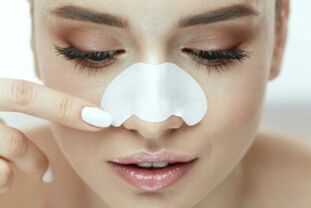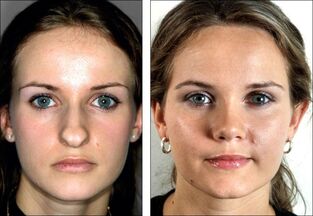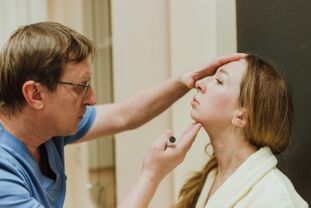Many have heard of classic surgical procedures, but non-surgical rhinoplasty is a relatively new technique in medicine and of course there are many questions about it. This article will tell you about the nuances of performing and rehabilitating non-surgical rhinoplasty. It is particularly useful for those who have complexes about nasal insufficiency but are not ready for surgery.
What is it and how is it done?
Non-surgical correction of defects consists in the installation of special fillers or threads, with the help of which the shape of the nose is corrected and symmetry is given.
This method is suitable for those with minor flaws who are not associated with breathing problems and a deviated septum or nasal bone.
This method cannot be described as a fully-fledged alternative to surgical intervention (with the exception of laser rhinoplasty), as some defects can only be corrected by classic rhinoplasty.

The differences between non-surgical and traditional rhinoplasty are as follows:
- Simplicity of execution, there is no long and painful rehabilitation phase (we have described here how rehabilitation takes place with conventional rhinoplasty);
- execution speed;
- affordable cost;
- short duration of the effect;
- Failed to fix serious problems.
It should be noted that thismethod can always be carried out when the effect is weakened.
Types of plastics without surgery
There can be several types of non-surgical rhinoplasty. How each of them is performed and how long the result lasts is detailed below.
injection
Nasal plastic with fillers - injection preparations that are used as fillers to correct defects due to tissue deficiency.The procedure causes no side effects,does not cause swelling and resolves by itself within 1. 5 years.
The nasal area is treated with an antiseptic and then the filler is injected subcutaneously. The entire procedure takes about half an hour, after which the patient can go home.
Fillers can be:
- biodegradable- made on the basis of organic substances - hyaluronic acid, collagen;
- biodegradable- synthetic substances - silicone and so on;
- autologous- the body's own fat tissue.
Injection rhinoplasty is also considered the administration of hormonal drugs. This procedure requires the utmost care and accuracy as the situation can worsen if the exact dosage is not followed.The effect after the procedure is quite long,, but complications in the form of tissue atrophy can occur.
Laser
In this case, a laser is used instead of a scalpel for plastic surgery, so the incisions are gentler and bleeding is eliminated due to the cauterization of the vessels.
The surgical approach to laser surgery does not differ significantly from classic rhinoplasty.
With the help of a laser, the surgeon's task is simplified, it is not only possible to accelerate the operation itself, but also to shorten the rehabilitation time. Before the operation, the patient needs to prepare, undergo tests and contact close specialists. With a correctly performed laser rhinoplasty, the result will last for a long time.
Threads
Many plastic surgeons do not find this type of nose job effective, so it is not a common practice. Most commonly, sutures are used to correct the shape of the tip of the nose or alar of the nose (read the techniques for conventional rhinoplasty of the ala, its tip and other parts here). The specialist makes small grooves where the threads are inserted. Leather and fabrics are fixed with artificial material. The effect lasts a long time.
Langettes
A langette is a special device that looks like a plastic clothespin. It is designed to be worn several hours a day to allow changes in the shape of the cartilage tissue to be achieved. However, it will take a few months for the pronounced effect to become apparent. You can fix minor flaws:
- returns the symmetry to the nose;
- stretches a little hump;
- Raise the tip of the nose (you will learn how to solve problems with the tip of the nose with the help of classic nose correction made from a special material).
- decreases the width of the wings.
Before and after photos
Next, we recommend that you familiarize yourself with the photos of patients before and after nasal surgery, which was performed without surgery.

Measured values
An injection rhinoplasty is performed in the following cases:
- hump on the bridge of the nose;
- flat top back;
- nasal asymmetry;
- dips and valleys;
- drooping tip of the nose;
- sharp corners of the nose;
- Need for correction after surgical rhinoplasty.
The indications for laser rhinoplasty are:
- changing the length of the nose;
- nose bridge too wide;
- unaesthetic bridge of the nose;
- broad or narrow tip;
- nostrils are too wide or too narrow;
- wing correction.
There are functional notes for this procedure:
- nasal injury with bone or cartilage fracture;
- congenital curvature of the bridge of the nose, which impairs the passage of air;
- Cartilage base defect.
Contraindications
A number of contraindications:
- Presence of an oncological disease;
- predisposition to allergic reactions - possible allergy to fillers injected under the skin;
- pregnancy and lactation period;
- early childhood - the cartilage tissue in children is not fully formed, and early correction can lead to a worsening of the situation in the future.
- It is not recommended to perform procedures during menstruation.
Why is this technique dangerous?
Although non-surgical rhinoplasty has only a very minor impact on the condition of the entire body, it can lead to undesirable consequences:
- Incorrect insertion of the filler under the skin can cause the helium lumps to move to the side over time, changing the resulting shape.
- There is a risk of infection and infection.
- Swelling and bruising appear immediately after the procedure, but in most cases these consequences go away within a few days without treatment.
- It is impossible to change the shape of the nose immediately after an unsuccessful procedure, since the drugs administered are persistent and it takes a few months for them to start splitting.
Other complications are:
- pain;
- reddening of the skin;
- embolic changes in the vessels;
- fibrotic changes at the injection site;
- allergies;
- whitish clusters in adjacent injection zones.
Complications can be short-term or long-term. With persistent deterioration in appearance or well-being, you should consult a specialist.
The most common types of complications after a non-surgical rhinoplasty are when the procedure is performed by a low-skilled doctor or in non-specialized salons.
To protect yourself from such inactive phenomena, you need to be responsible when choosing the clinic and the doctor who will lead the procedure and, if necessary, properly prepare for the procedure. In addition, it is necessary to inform the doctor in advance about the existing diseases, including chronic ones, since the choice of technique depends on it.
Here we've talked about the consequences patients can expect after a classic nose job and how they can be avoided.
Rehabilitation

The specialty of non-surgical rhinoplasty is that it has a short rehabilitation period. On average, it takes 1-2 days for all bruises and bruises to go away. The swelling of the tissue can last up to 5 days. In order to reduce it more quickly, it is recommended to apply ice compresses to the exposure site in the first hours after the procedure. This will prevent edema from spreading.
Overview table
| Type of retinoplasty | Advantages | Disadvantages/ zxtr> |
| Fillers |
|
|
| Hormonal injections |
|
|
| Laser |
|
|
| Threads |
|
|
| Langette |
|
|
Dissatisfaction with one's own appearance is often the cause of a person's complexity, the development of depression and psychosis. But sometimes it is enough just to pull up the tip of your nose a little so that life sparkles with bright colors and self-confidence is created.
But not all people, even if they are very dissatisfied with their appearance, can afford a classic rhinoplasty - some are afraid of the price, others are afraid of complications and unsuccessful operations and some are afraid of a long period of rehabilitation. In this case, it makes sense to think about a nonsurgical rhinoplasty, which, although it may not be a full-fledged alternative to surgery, can easily cope with some disadvantages.






















